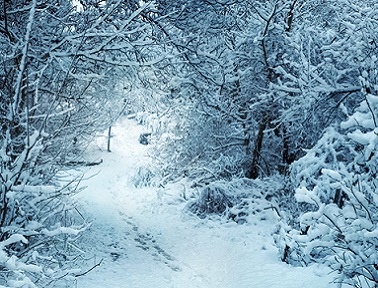It’s Snowing! Fun with Crystals
- January 20, 2014
- By Robin Koontz
 “This stuff falls from the sky; we ought to know how it works. I feel that with over six billion people on the planet, surely a few of us can be spared to ponder the subtle mysteries of snowflakes.” — Physicist Kenneth G. Libbrecht
“This stuff falls from the sky; we ought to know how it works. I feel that with over six billion people on the planet, surely a few of us can be spared to ponder the subtle mysteries of snowflakes.” — Physicist Kenneth G. Libbrecht
Snowflakes falling from the sky can prompt a science session (or two, or more) using crystals. Actually, a snowflake is the term used for a single snow crystal or, a group of snow crystals that are stuck together. To note, snow crystals are not frozen rain; that’s called sleet. Sleet particles don’t have the symmetrical patterns of snow crystals.
The birth of a snowflake is a good science lesson about weather and the water cycle. Oceans, lakes, and rivers put water vapor into the air. Transpiration from plants adds to the mix. When the water vapor cools in the air, the vapor starts to condense. High up in the sky the water vapor condenses onto dust particles, forming clouds. In winter we can get snow-forming clouds.
A snow crystal begins as a tiny cloud droplet that freezes. Here’s where some geometry and symmetry also kick in: water vapor in the cloud condenses on the frozen particle’s surface and it develops into a tiny hexagonal (6-sided) prism. As the snow crystals fall, water vapor around them continues to stick to the ice crystal, building on to the original form. Since snow crystals are hexagonal prisms, they have six corners. Snow crystals will grow exactly six arms from the corners, all at the same rate, growing in a perfectly symmetrical pattern!
The complex shape of a single arm of this ice crystal depends on what’s going on around it as it falls – for instance moisture and temperature. The arms might branch off in new directions in an infinite variety of patterns. But since each arm is subject to the same conditions as the crystal flies through the air, they all remain pretty much identical unless dust or some other factor causes it to be lop-sided.
Every individual snow crystal follows a separate path as it travels through the air. Since they experience different atmospheric conditions, each snow crystal will tend to look unique. That’s why people will say that no two snowflakes are exactly alike.
If you can take the kids outside during a snow shower, they can study flakes that they catch on a cloth, quick, before they melt! Or try this activity with superglue. I haven’t tried it, so can’t guarantee it will work, but it sounds cool for older kids:
Superglue Snow Crystals
You’ll need:
Microscope slides
Cover slips
Superglue
Tweezers and/or soft paintbrush
Cardboard or cloth for collection (dark color helps)
A cold snowy day (drier snow works best)
1. Chill the slides, slips, and superglue. You want them to be as cold as the air around them.
2. Let snowflakes fall on the collector. Pick one up using tweezers or paintbrush – this might take some practice – and place it on a slide.
3. Put a drop of the cold superglue on the crystal and drop a cover slip on top.
4. Leave the slide outside (if it’s going to stay cold) or in a freezer for a week or so, until the glue hardens. You will have a beautiful preserved snowflake (hopefully!)
For a boatload of information about snowflakes, I recommend: http://www.its.caltech.edu/~atomic/snowcrystals/
and:
Secret Life of a Snowflake: An Up-Close Look at the Art and Science of Snowflakes by Kenneth Libbrecht
Snow crystals are only one kind of crystal. A crystal is always a solid with atoms that are arranged in orderly patterns that repeat themselves. Each collection of atoms is called a Unit Cell. The unit cells repeat in exactly the same arrangement over and over again. Quasicrystals are a bit more complicated. Their patterns are subtle and don’t appear at exact intervals. But they are still crystals.
Crystals can grow into some very interesting forms and in very interesting places! They crystallize from all kinds of materials. Diamonds form when carbon atoms are subjected to high temperature and pressure. They grow deep in the earth where the temperature is hot and pressure is high. When other carbon atoms get close, they will attach. The process of atoms locking into place and repeating a network is the way all crystals grow. One little diamond crystal represents billions of carbon atoms.
Crystals can come in a variety of colors, too. Sometimes the color is from the environment they were exposed to. For instance, topaz comes in many colors because of the presence of different chemicals that affect its appearance. But the color of anything depends on how it absorbs light. This is a good excuse to talk about the electromagnetic spectrum. Snow crystals appear to be white because they have so many light-reflecting surfaces they scatter the light into all of its colors, so snow appears white.
Here are a bunch of microscopic images of all kinds of crystals that would be very hard to guess:
http://www.denniskunkel.com/gallery/4-0-crystals.html
And finally here are recipes for growing your own crystals, including some that use easy ingredients:
http://chemistry.about.com/od/growingcrystals/tp/Make-Crystals.htm
My favorites are the Epsom Salt Crystal Needles– a great way to have fun with crystals!


